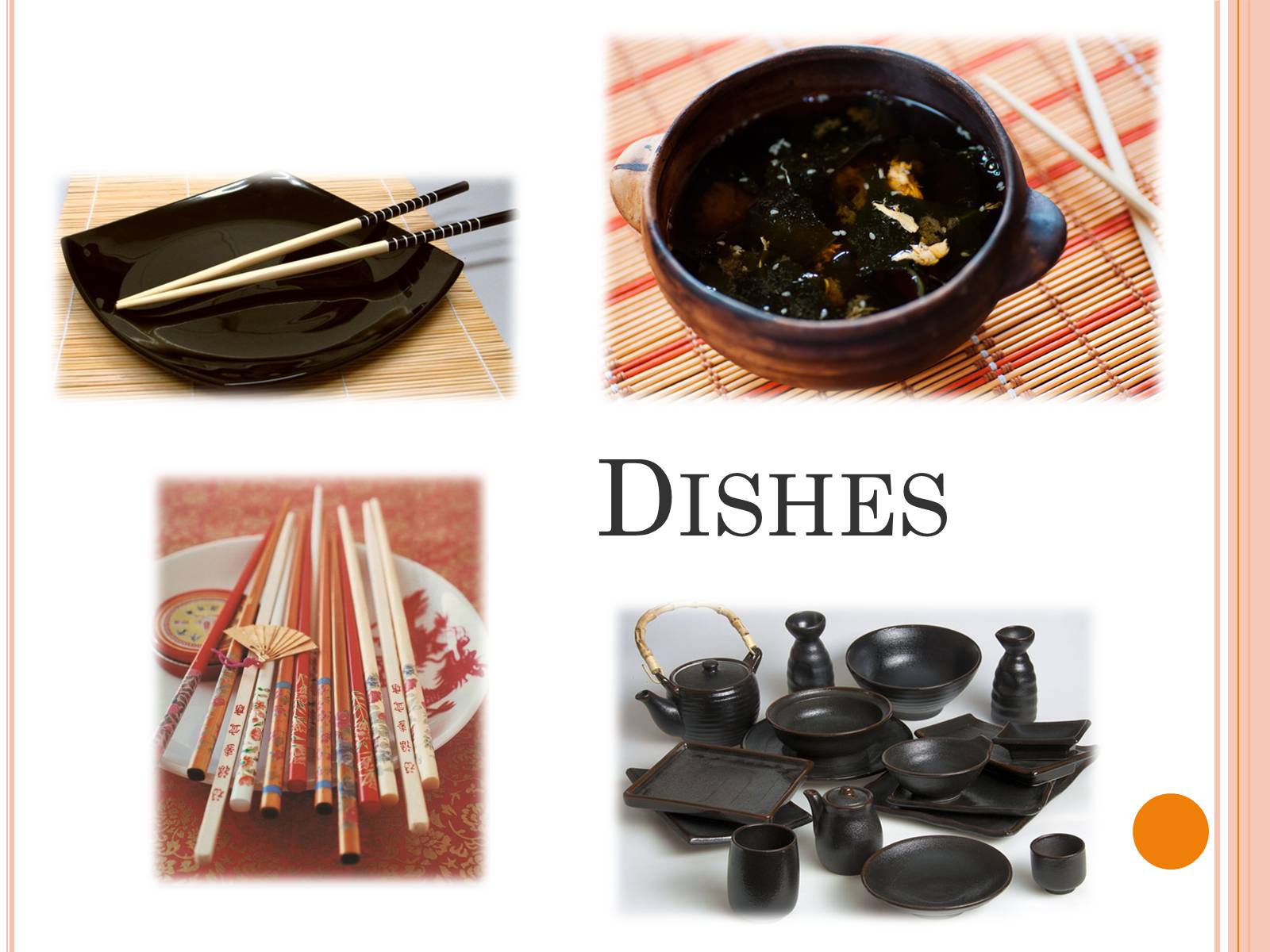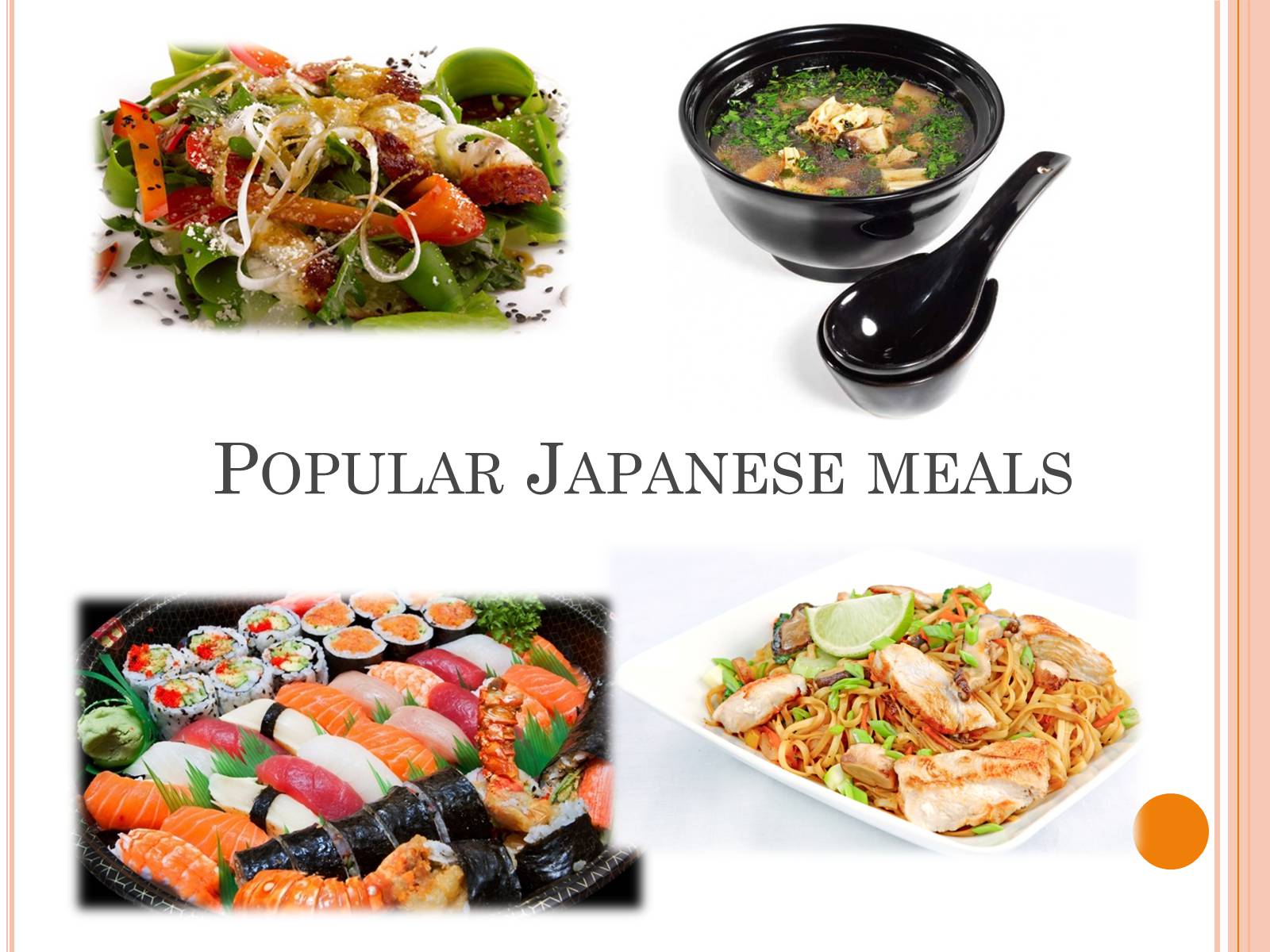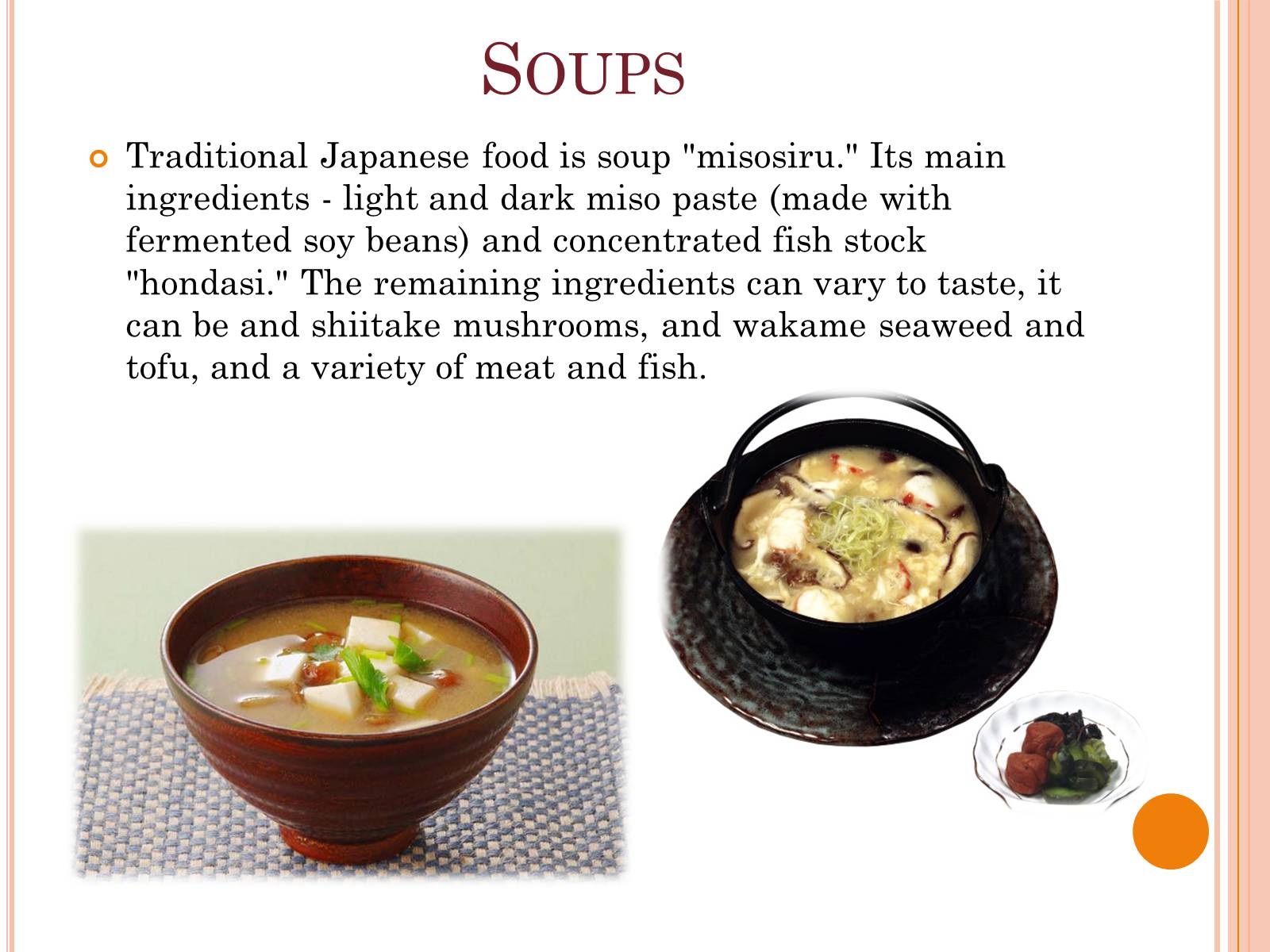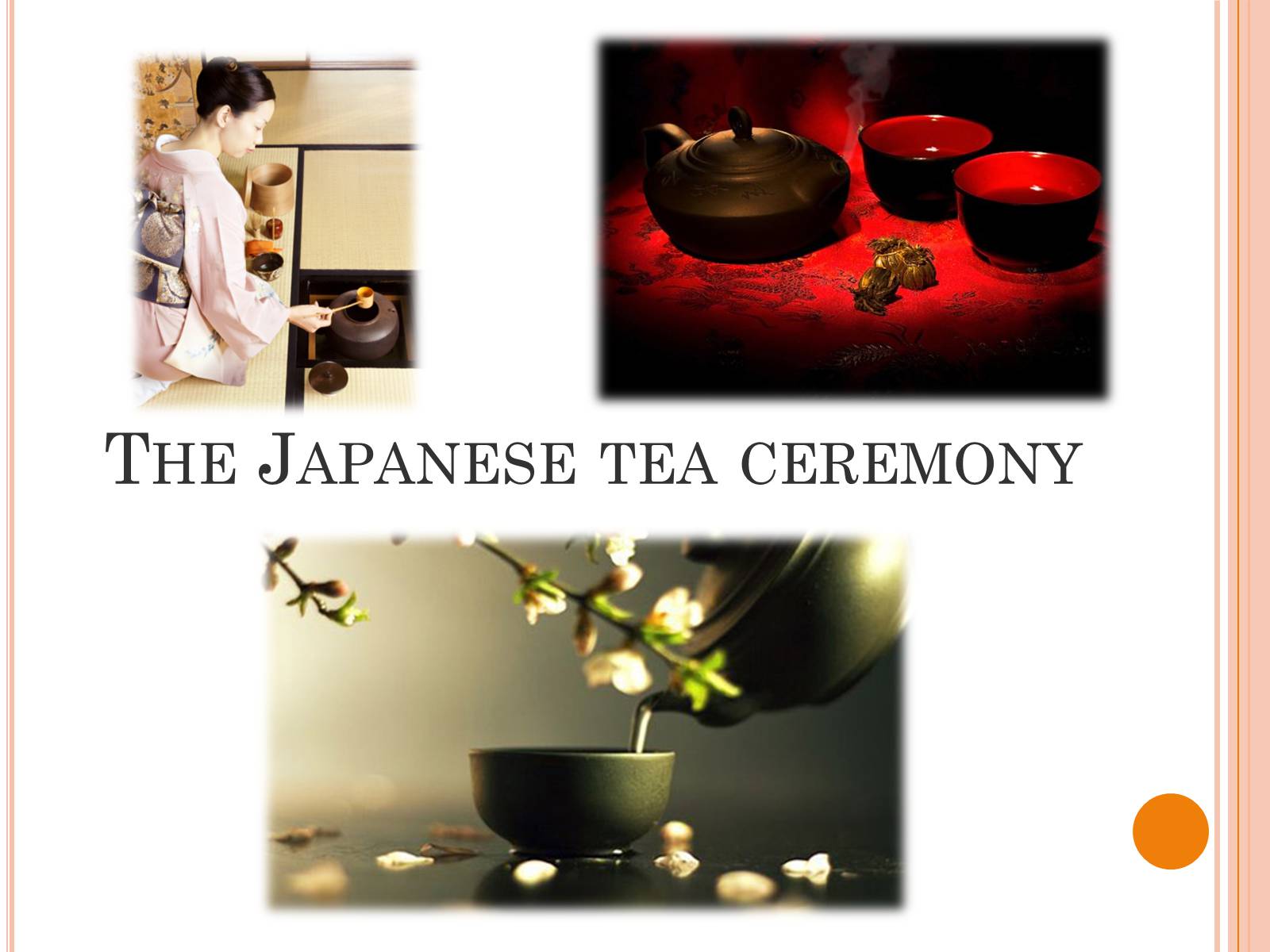- Головна
- Готові шкільні презентації
- Презентація на тему «Japanese cuisine» (варіант 1)
Презентація на тему «Japanese cuisine» (варіант 1)
126
Слайд #1
Japanese cuisine

Слайд #2
The traditional food of Japan is based on rice with miso soup and other dishes, each in its own utensil, with an emphasis on seasonal ingredients. The side dishes often consist of fish, pickled vegetables, and vegetables cooked in broth. Fish is common in the traditional cuisine. It is often grilled. Fish may be served raw as sashimi or in sushi. Seafood and vegetables are also deep-fried in a light batter as tempura.

Слайд #3
The most characteristic features of Japanese cuisine:
Use mostly fresh food, be sure of high quality. Practically applied products are "long-term storage," except for rice and sauces.
A huge range of seafood, used for cooking.
The desire to preserve pristine appearance and flavor of the ingredients in the dish. This Japanese cuisine is different from most of Asia, where the products are in the process of making changes often beyond recognition.
Seasonality of supply.
Small portions. The amount of food is dialed by a greater variety of dishes, and not the size of portions.
Specific cutlery - most dishes to eat with chopsticks, some can eat with your hands, spoons are used very rarely, forks and knives are not used at all. For this reason, most of the dishes served in small pieces that are easy to take the sticks and do not have to share.
Sharply distinguished from the European design principles dishes serving. Do more than in European cuisine, the emphasis on the aesthetic appearance of dishes and table as a whole.
Specific table manners.
Use mostly fresh food, be sure of high quality. Practically applied products are "long-term storage," except for rice and sauces.
A huge range of seafood, used for cooking.
The desire to preserve pristine appearance and flavor of the ingredients in the dish. This Japanese cuisine is different from most of Asia, where the products are in the process of making changes often beyond recognition.
Seasonality of supply.
Small portions. The amount of food is dialed by a greater variety of dishes, and not the size of portions.
Specific cutlery - most dishes to eat with chopsticks, some can eat with your hands, spoons are used very rarely, forks and knives are not used at all. For this reason, most of the dishes served in small pieces that are easy to take the sticks and do not have to share.
Sharply distinguished from the European design principles dishes serving. Do more than in European cuisine, the emphasis on the aesthetic appearance of dishes and table as a whole.
Specific table manners.

Слайд #4
Ingredients

Слайд #5
Rice
Is the main ingredient of Japanese cuisine and staple food in Japan at all. In Japanese, the word "gohan" (cooked rice), like the Russian "bread," means not only a certain food, but the food at all.
For Japanese cuisine preferred rice varieties, with improved adhesion when cooking - in the preparation of such rice dish has a structure of small lumps that are easy to eat with chopsticks. Rice is prepared as a separate dish and used as an ingredient in the preparation of a set of "combined" dishes.
Is the main ingredient of Japanese cuisine and staple food in Japan at all. In Japanese, the word "gohan" (cooked rice), like the Russian "bread," means not only a certain food, but the food at all.
For Japanese cuisine preferred rice varieties, with improved adhesion when cooking - in the preparation of such rice dish has a structure of small lumps that are easy to eat with chopsticks. Rice is prepared as a separate dish and used as an ingredient in the preparation of a set of "combined" dishes.

Слайд #6
Seafood
Fish, shellfish, marine animals in Japanese cuisine are the second most important component after rice. As a rule, when they are preparing only a small heat treatment (roasting, steaming), and in some of the dishes (sashimi) is included just raw.
Used in Japanese cuisine and algae.
Fish, shellfish, marine animals in Japanese cuisine are the second most important component after rice. As a rule, when they are preparing only a small heat treatment (roasting, steaming), and in some of the dishes (sashimi) is included just raw.
Used in Japanese cuisine and algae.

Слайд #7
Soybean
Soy was brought to Japan from China, it is used in Japanese cuisine in a variety of forms:
Tofu (soybean curd or tofu) - nourishing base for many dishes.
Soy sauce - condiment, is very widely used.
Soybean paste miso soup.
Fermented natto beans
Soy was brought to Japan from China, it is used in Japanese cuisine in a variety of forms:
Tofu (soybean curd or tofu) - nourishing base for many dishes.
Soy sauce - condiment, is very widely used.
Soybean paste miso soup.
Fermented natto beans

Слайд #8
Dishes

Слайд #9
Bowl of soup
For dishes with plenty of fluids, mostly - for soups, use a deep round bowl, resembling large salad bowl or European, with a cover of the same material as the bowl itself. Traditional European soup plate for soup, the "fields" that Japan completely uncharacteristic.
Chopsticks
Basic cutlery. Sticks are very diverse and are used as a universal tool for the use of any food.
Tea things
Japanese teapots are usually spherical, oblate shape, or form a flattened sphere with a cut bottom. The handle of a traditional kettle is located above and attached to the teapot for two ears, located on opposite sides of the lid. In addition to traditional materials, the Japanese tea may be made of tea-things are not typical for the material, as iron.
The Japanese cups height and diameter, or nearly the same, or the height of the diameter. Sometimes drinking tea from tiny cups, containing not more than 50 ml, but this is not the general rule.
The cups are cylindrical or barrel-shaped, without handles.
For dishes with plenty of fluids, mostly - for soups, use a deep round bowl, resembling large salad bowl or European, with a cover of the same material as the bowl itself. Traditional European soup plate for soup, the "fields" that Japan completely uncharacteristic.
Chopsticks
Basic cutlery. Sticks are very diverse and are used as a universal tool for the use of any food.
Tea things
Japanese teapots are usually spherical, oblate shape, or form a flattened sphere with a cut bottom. The handle of a traditional kettle is located above and attached to the teapot for two ears, located on opposite sides of the lid. In addition to traditional materials, the Japanese tea may be made of tea-things are not typical for the material, as iron.
The Japanese cups height and diameter, or nearly the same, or the height of the diameter. Sometimes drinking tea from tiny cups, containing not more than 50 ml, but this is not the general rule.
The cups are cylindrical or barrel-shaped, without handles.

Слайд #10
Popular Japanese meals

Слайд #11
sushi
Are made from a specially cooked rice and raw seafood. Form of sushi is very diverse, and in the preparation used in almost any seafood. There are two main types of sushi. The first - the actual sushi (nigiri, tataki, and others), is a small, elongated lump of rice, which is laid on top of a piece of fish, shrimp, and some types of sushi wrapped in a strip of seaweed, forming together with the rice container, which is filled from the top chopped seafood , eggs or vegetables. The second type - the so-called roll, characterized by a fundamentally different way of cooking: rice and seafood layers laid on a sheet of seaweed, roll into a thin roll, which is then cut crosswise into small pieces with a sharp knife.
Sushi served on a flat plate or a wooden stand, with horseradish wasabi, soy sauce and pickled ginger gari.
Are made from a specially cooked rice and raw seafood. Form of sushi is very diverse, and in the preparation used in almost any seafood. There are two main types of sushi. The first - the actual sushi (nigiri, tataki, and others), is a small, elongated lump of rice, which is laid on top of a piece of fish, shrimp, and some types of sushi wrapped in a strip of seaweed, forming together with the rice container, which is filled from the top chopped seafood , eggs or vegetables. The second type - the so-called roll, characterized by a fundamentally different way of cooking: rice and seafood layers laid on a sheet of seaweed, roll into a thin roll, which is then cut crosswise into small pieces with a sharp knife.
Sushi served on a flat plate or a wooden stand, with horseradish wasabi, soy sauce and pickled ginger gari.

Слайд #12
Soups
Traditional Japanese food is soup "misosiru." Its main ingredients - light and dark miso paste (made with fermented soy beans) and concentrated fish stock "hondasi." The remaining ingredients can vary to taste, it can be and shiitake mushrooms, and wakame seaweed and tofu, and a variety of meat and fish.
Traditional Japanese food is soup "misosiru." Its main ingredients - light and dark miso paste (made with fermented soy beans) and concentrated fish stock "hondasi." The remaining ingredients can vary to taste, it can be and shiitake mushrooms, and wakame seaweed and tofu, and a variety of meat and fish.

Слайд #13
The Japanese tea ceremony

Слайд #14
Tea Ceremony - a specific form of ritualized sharing tea, created in the Middle Ages in Japan and is currently cultivated in the country. Appearing originally as a form of meditation Buddhist monks, was an integral part of Japanese culture, which is closely linked to many other cultural events.

Слайд #15
Place of the ceremony
Classic tea ceremony is held in a specially equipped place. Usually it is a fenced area, which can enter through the massive wooden gate. Before the ceremony, while collecting guests doors open, giving guests the opportunity to enter without disturbing the owner, employee training. On the territory of "tea set" is a few buildings and a garden. The main building - the tea house (tyasitsu) - located deep in the tea garden (tyaniva). To get there you have to walk through the garden on stone-paved path (Rhodes).
Classic tea ceremony is held in a specially equipped place. Usually it is a fenced area, which can enter through the massive wooden gate. Before the ceremony, while collecting guests doors open, giving guests the opportunity to enter without disturbing the owner, employee training. On the territory of "tea set" is a few buildings and a garden. The main building - the tea house (tyasitsu) - located deep in the tea garden (tyaniva). To get there you have to walk through the garden on stone-paved path (Rhodes).

Слайд #16
conclusion

Слайд #17
Doing a presentation about Japanese cuisine, I met with the country's traditions, with its national dishes. Japan - amazing country. Everything is unique here - cities, language, culture. Japan - Land of the Rising Sun.
THANKS FOR LOOKING :)
THANKS FOR LOOKING :)
